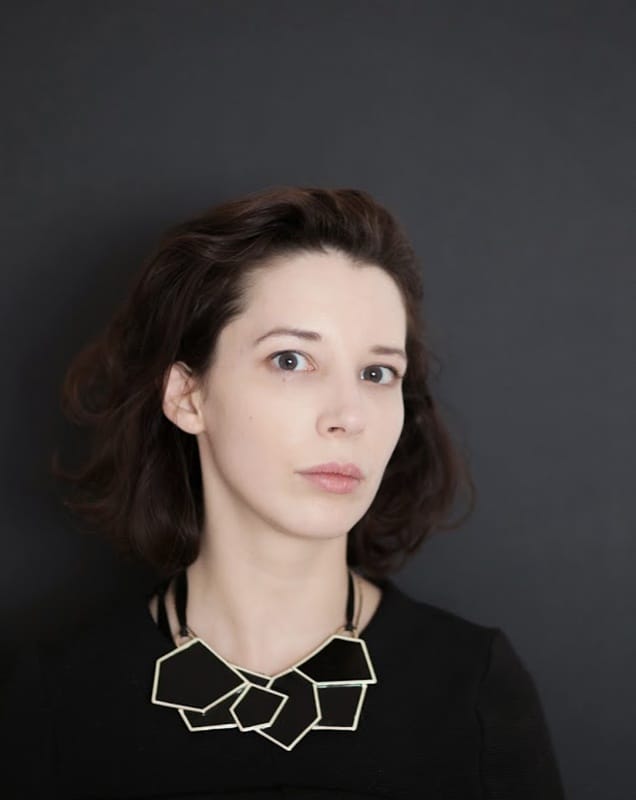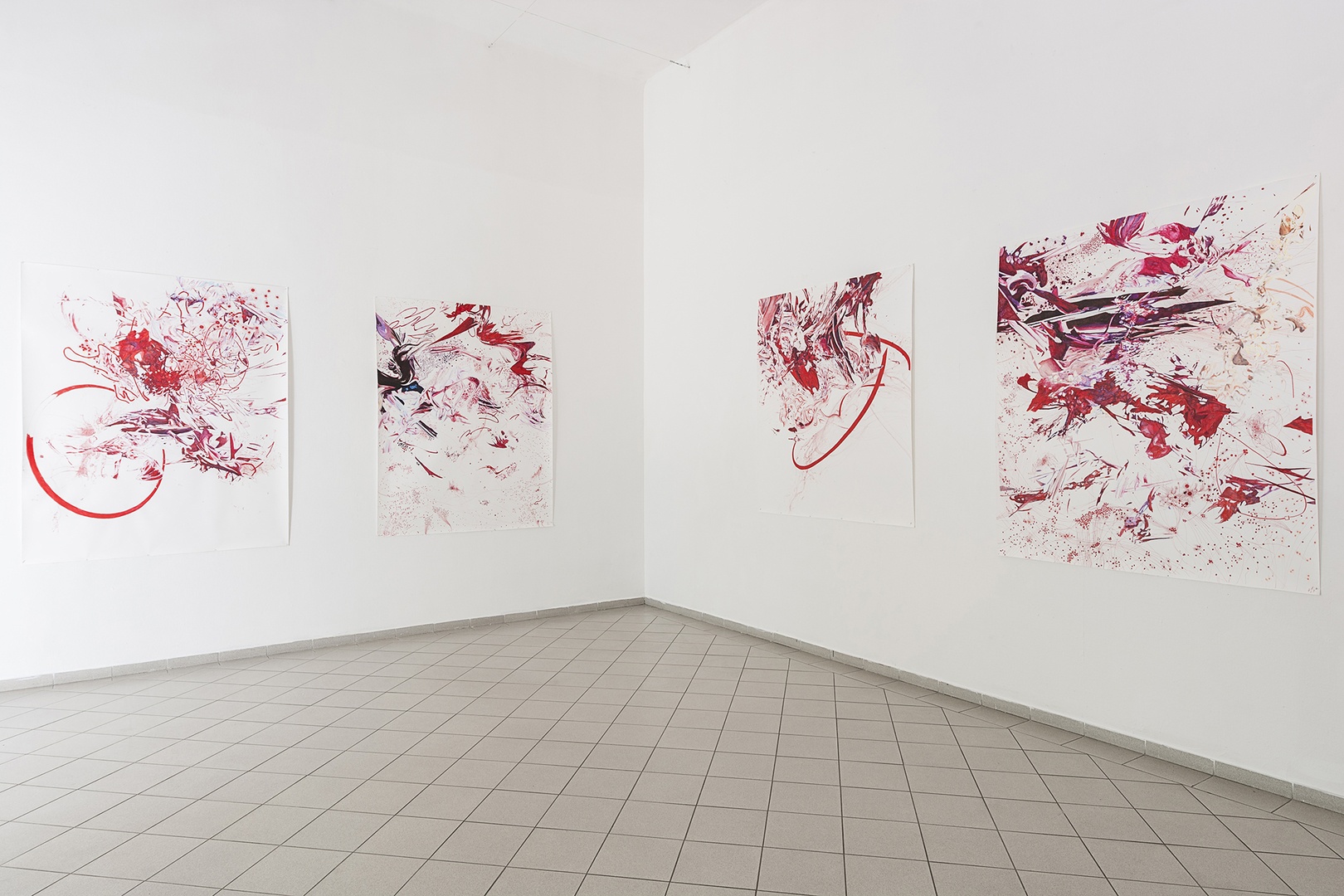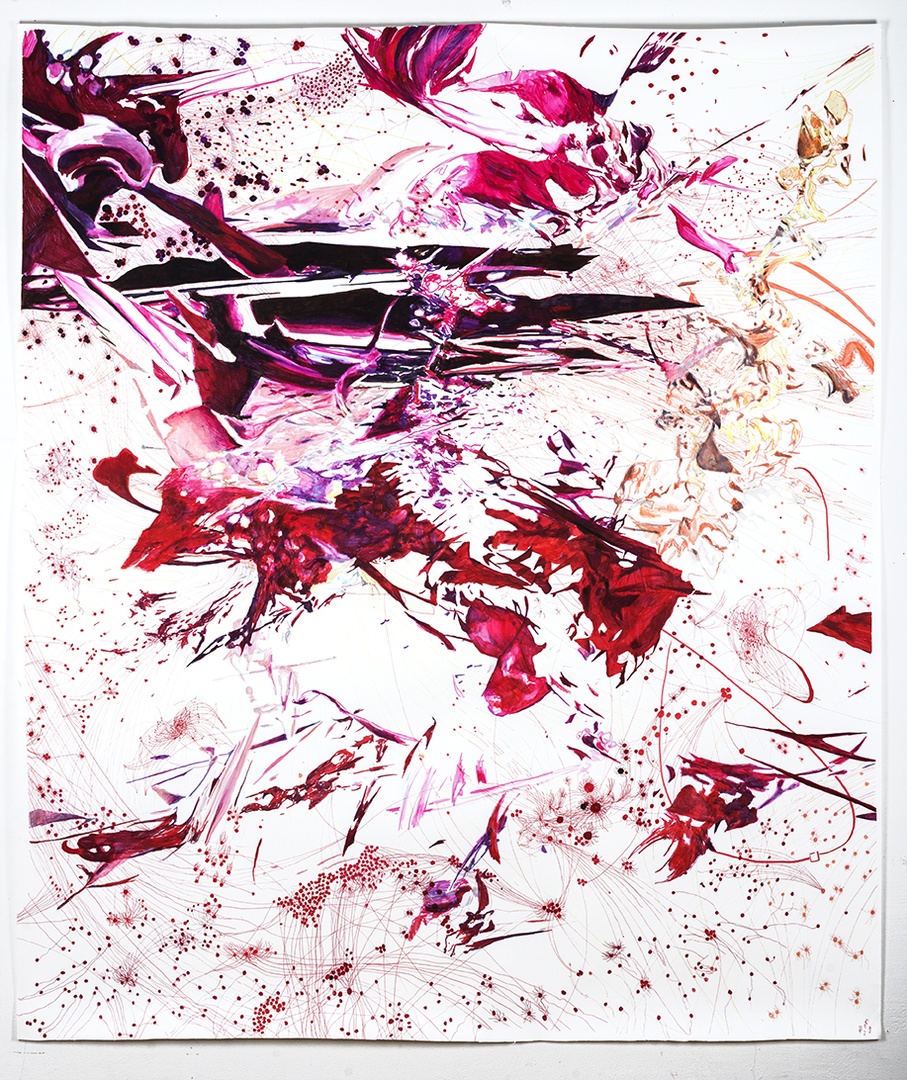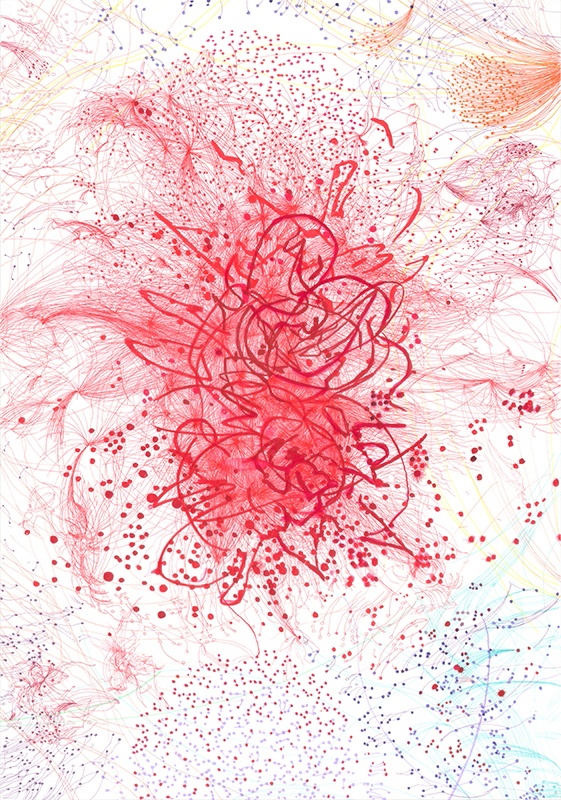Polish Warsaw-based artist Maess presents her newest series of drawings „Abnormal results” at Platan Gallery in Budapest. Artist known for an explorative approach to mediation between technology and drawing activity in her project examines aspects of human body’s fragility. We asked Maess to share her views on applied techniques, inspirations and experiences behind these works.

Maess, Metastasis study, 55 x 21cm, marker and pen on paper, 2015
Patrycja Rup: Exhibition in Platan Gallery includes numerous drawings, some of them were already presented at “The Drawers” group exhibition at Kasia Michalski Gallery in Warsaw. When did you start creating this series? What was the main goal of this project?
Maess: Since 2012, I have been fascinated by the complexity of the technology implemented for data visualisations, which inspired me to create drawings derived from data sets called “United Networks”. The subject of cancer evolved slowly from these works. However, it was personal events that triggered my reflection on the disease and re-invoked a curiosity in biology. I felt that the vast scientific data available from graphs and technical drawings, did little to express the fears of pain, disease and death. In 2013, “Abnormal Results” emerged. Studying research done in attempts to cure cancer and developments in this field, I have become captivated by the interwoven processes of both normal and pathological growth and the perplexity of the unknown mechanisms behind them. The intention of this project is to capture all these thoughts, which are overwhelming from an informative point of view itself, and dwell into the emotional burden in a context of the vulnerability of a human being.
PR: “Abnormal results” is based on the wide medical research, what sources did you use in the project?
M: In total, three sources of data are combined to create the works. The least transformed source are pictures from histopathology reports with varied views of normal and cancer cells. The second type are spiderweb like clusters generated in data visualisation software illustrating, for example, incidence of cancer or cancer-related conversations on Twitter. Separately, simple two dimensional graphs, such as cancer survival rates, are fed into 3D software as used in architectural visualisations, to which I then add my own dimensional parameter to render shapes and forms. The dimensional parameter that I manipulate is a metaphor for the “unknown” control mechanism within the realm of “known” factors behind the cancerous processes.
PR: In your works you use different strategies and techniques, from marker sketches to watercolour. Why do you find creating a drawing after generating high-tech digital picture important?
M: “Abnormal results” is about mortality, fragility, beauty of decay. To have only rendered an image digitally, would have left the work with an impression of detachment and impersonality. It was essential to further engage with the works by drawing in order to retain the fragility of a human hand touch and most importantly, a sense of imperfection.
PR: “Abnormal results” attracts attention with its vivid red colors, what does the colour mean to you?
M: Red as a colour is hard to ignore. It is used for warning signs (red flag), a symbol of passion, but also massacre and haemorrhage. For this reason, I use red to make typographical marks for the viewer to “navigate” across my works.
PR: Lately you started widening the range of techniques and applying other colours like purple and blue, how do you see the evolution of the presented works from the typographic „J’ai Tres Envie De Toi” to the latest drawings?

Maess, Fall in platelet,100x 70cm, marker and pen on paper, 2013
M: In my earlier works, “Excessive”, made in 2009, I used acronym JTEDT as a sort of wax seal that symbolised carnal desire. In “Abnormal Results” ,there are remnants of JTEDT, however the typography exists as passion transformed into the Schopenhauerian “Will-to-live” , desire to survive, despite the circumstances. In the words of Kandinsky; “Colour is the keyboard, the eyes are the harmonies, the soul is the piano with many strings. The artist is the hand that plays, touching one key or another, to cause vibrations in the soul.” In my recent works I expand repertoire of colours which are consistent with my subjective reports of synesthetes. Synesthesia can manifest in many forms, in my case I see the words, letters and sounds in a certain colour.
PR: In your works (and in interviews) you refer often to Polish artist Alina Szapocznikow. How her sculptures influenced your works?
M: The works of Szapocznikow did not influence me in the process of creating the “Abnormal Results” cycle. Szapocznikow’s sculptures and my works are very diffrent take on the same topic. Alina Szapocznikow focused her attention on what was visible on the surface of a body, her body, racked with disease. What I draw is cancer seen from a cellular level, using wide complex data sets and networks. My works are rather influenced by latest technological breakthroughs. As a person living in XXI century I have a plethora of resources at my fingertips; reading all sorts of discussion boards, medical publications, blogs of patients, clinical trials promises, studying survival rate calculators, and hence a very different approach. Such images were not available to Szapocznikow nearly 50 years ago. However, her works are very important to me because they provide a reflection on how our contemporaneity shapes the way an artist conceives and executes ideas and how an artist’ life and work is an intertwined Zeitgeist.
Interviewed by: Patrycja Rup
Maess ‘Abnormal results’ curated by Tomasz Piars
16 September – 15 October 2015
Platan Gallery, Andrássy út 32. Budapest

Maess, portrait, photo Andrzej Skrzypek

Exhibition views, Platan Gallery Budapest, courtesy of artist

Exhibition views, Platan Gallery Budapest, courtesy of artist

Maess, Metastasis III, 190 x 150 cm, marker on paper, 2015

Maess, Beautiful things are afoot,100x 70cm, marker and pen on paper, 2013











